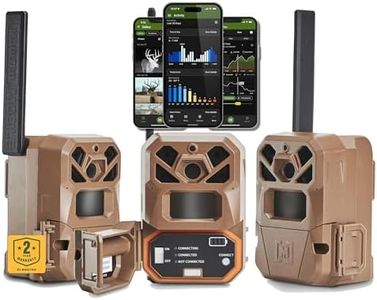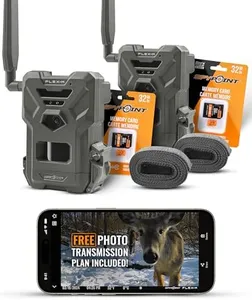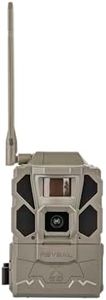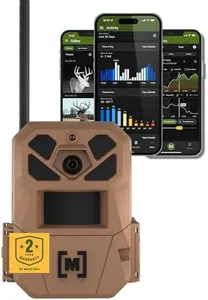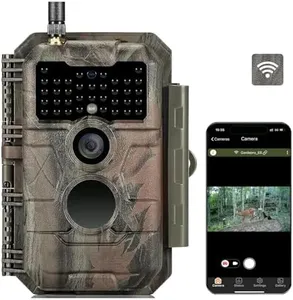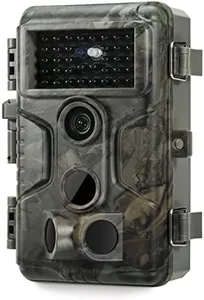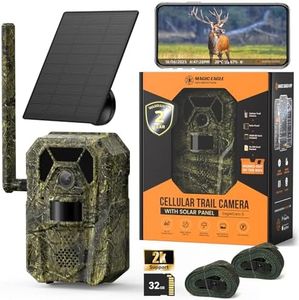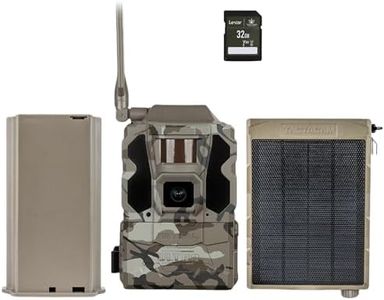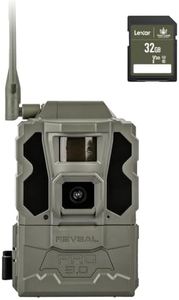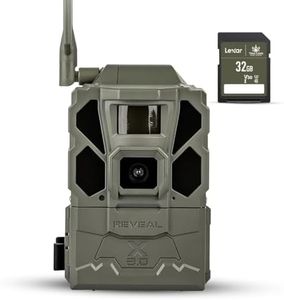10 Best Cellular Trail Camera 2025 in the United States
Our technology thoroughly searches through the online shopping world, reviewing hundreds of sites. We then process and analyze this information, updating in real-time to bring you the latest top-rated products. This way, you always get the best and most current options available.

Our Top Picks
Winner
Moultrie Edge 2 Cellular Trail Camera - Auto Connect Nationwide 4G LTE - On Demand 36MP Photo - 1080P Video with HD Audio - 100 Ft Detection Range - Low Glow Flash
Most important from
2689 reviews
The Moultrie Edge 2 Cellular Trail Camera is designed for hunters and outdoor enthusiasts who want clear, detailed images and reliable cellular connectivity across the U.S. It takes excellent 36MP photos and records 1080p videos with audio, delivering sharp daytime and nighttime shots thanks to its advanced sensor and 100-foot detection range. Its low-glow infrared flash helps capture wildlife without spooking them. The camera connects automatically to 4G LTE networks nationwide, eliminating the need to swap SIM cards or manage separate data plans, which enhances convenience for remote monitoring.
With an internal 8GB memory plus unlimited cloud storage via the Moultrie Mobile app, you can view and manage photos remotely, receive instant alerts, and analyze animal movement patterns to improve scouting. Setup is straightforward through the app, which also allows you to adjust settings and track battery life. The camera runs on batteries, so for extended use, optional solar panels or battery packs are available separately.
The camera relies on a cellular signal in your area for real-time updates, and while the internal memory serves as a backup, the cloud storage requires a subscription through Moultrie. Its weatherproof design and versatile mounting options add to its convenience for outdoor use. If you want a reliable trail camera with high-quality images and nationwide cellular service without dealing with SIM cards, the Moultrie Edge 2 is a strong option, especially if you consider the ongoing subscription for cloud storage and potential power accessories for longer battery life.
Most important from
2689 reviews
SPYPOINT Flex-M Twin Pack Cellular Trail Cameras - 2 SD Cards Included, Best Hunting Accessories, No WiFi Needed, GPS, Night Vision, IP65 Water-Resistant, 28MP Photos, & 720p Videos + Sound (2)
Most important from
2284 reviews
The SPYPOINT Flex-M Twin Pack is a solid choice for anyone needing cellular trail cameras for hunting or wildlife observation. It delivers sharp 28MP photos and decent 720p videos with sound, which is good enough for identifying animals and reviewing activity. The cameras use a fast CMOS sensor and offer multiple capture modes including photos, videos, and time-lapse, giving good flexibility. Battery life benefits from compatibility with an optional solar panel, helping you keep the cameras running longer without frequent battery changes.
Cellular connectivity works across carriers automatically, so there’s no hassle setting it up or worrying about signal issues — plus, the included free photo transmission plan allows up to 100 photos monthly without fees, which is quite convenient for casual users. Night vision is built-in and effective, supporting monitoring in low light or darkness. Each camera includes a microSD card for local storage, giving extra backup alongside cellular transmission. The SPYPOINT app makes managing the cameras easy right from your phone, including remotely adjusting settings and receiving photos instantly without needing WiFi.
The video resolution is limited to 720p, which isn’t very sharp compared to some higher-end models. Also, since batteries are required but not included, you’ll need to purchase those separately. Some advanced features like buck tracking AI work best in specific regions or conditions. If you want a dependable, user-friendly cellular trail camera with good image quality and flexible capture options, especially at a reasonable price, the SPYPOINT Flex-M Twin Pack is worth considering. For those requiring ultra-high video clarity or the longest battery life out of the box, exploring other models may be advisable.
Most important from
2284 reviews
TACTACAM Reveal X Gen 3.0 Cellular Trail Camera: Auto Connect 4G LTE, 4K Photo, 1080p Video, Low-Glow IR Flash, No SD Card Needed, Long Battery Life – Best Hunting, Game & Property Monitoring Camera
Most important from
642 reviews
The TACTACAM Reveal X Gen 3.0 is a solid choice if you want a cellular trail camera that combines good video quality with reliable connectivity. It shoots 1080p full HD videos and takes sharp photos with a 3-shot burst mode, which helps capture fast-moving wildlife clearly. The low-glow infrared LEDs allow for night vision up to 96 feet, so it performs well in low light without scaring animals. Its trigger speed is fast, meaning it quickly starts recording when motion is detected, and the detection range aligns well with typical outdoor needs.
One standout feature is the built-in cellular connectivity compatible with AT&T and Verizon networks, allowing you to check images remotely through your smartphone without needing an SD card, thanks to its built-in storage. This makes it very convenient if you want to monitor your property or hunting areas in real time. The camera also supports firmware updates over the air, ensuring it stays current with new features. Battery life is described as best-in-class, which is crucial since cellular cameras can drain batteries quickly. The new antenna design also improves signal strength, enhancing connection reliability. Additionally, the camera includes GPS for precise location tracking, benefiting those who use multiple cameras across large areas.
On the downside, the field of view is 60 degrees, which is narrower than some cameras, so you might need to place it carefully to cover desired areas. The camera is battery-powered, meaning you’ll need to keep an eye on power levels, especially with frequent video captures. It also has no SD card by default, so while built-in storage is convenient, you might miss the flexibility of swapping cards in the field. This camera suits hunters and outdoor enthusiasts who want robust cellular connectivity, good video quality, and reliable night vision. It’s also helpful for property security, given its quick alerts and remote viewing. Just be mindful of placement due to the moderate viewing angle and plan for battery upkeep during extended use.
